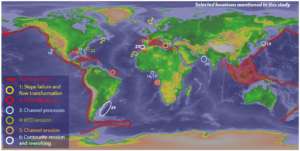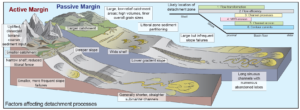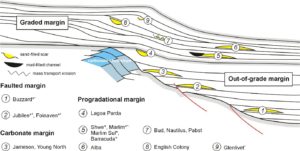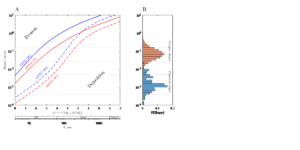14th July 2020
Abstract
Upslope stratigraphic traps in turbidite systems: insights from producing fields, modern sea-floor systems and sediment transport models
Lawrence Amy1+*, John Counts1,2+, Robert Dorrell3*, Bill McCaffrey4*, Peter Haughton1+ & Aggie Georgiopoulou5+
1School of Earth Sciences, University College Dublin, Dublin 4, Ireland. lawrence.amy@ucd.ie
2United States Geological Survey, Eastern Energy Resources Science Center, 12201 Sunrise Valley Dr., Reston, VA, 20191, USA.
3Energy and Environment Institute, University of Hull, Hull, HU6 7RX.
4School of Earth and Environment, University of Leeds, Leeds, LS2 9JT, United Kingdom.
5School of Environment and Technology, University of Brighton, Lewes Road, Cockcroft Building, BN2 4GJ, Brighton, United Kingdom.
+Irish Centre for Research in Applied Geosciences (iCRAG), O’Brien Centre for Science, University College Dublin, Dublin 4, Ireland.
*Leeds Turbidite Research Group, University of Leeds, UK.
Detached turbidite systems with updip pinchouts toward their proximal margin provide opportunities for stratigraphic traps in many deepwater petroleum systems. This play type offers the potential for giant world-class discoveries, making them a major focus in deepwater drilling environments where high-rate, high-ultimate-recovery reservoirs are required for commercial success. Over the last few decades stratigraphic traps of Cretaceous and Tertiary deepwater turbidite complexes have been extensively drilled in passive margin settings, especially on both sides of the equatorial Atlantic. Prominent successes reported to have pure or combined traps, include the offshore Ghana, Jubilee Field (~0.6 BOE), offshore Guyana, Liza Field (~1 BOE) and offshore Senegal, Fan-1 discovery (~ 0.9 BOE). However, widespread success in this play type has been difficult to replicate with many drilled prospects lacking either or both effective closure and containment. This suggests that, despite significant advances in seismic imaging, our ability to predict stratigraphic prospects with robust traps and seals remains limited.
This talk will outline results from a number of studies which used different approaches to give a better understanding of upslope stratigraphic traps:
1) an assessment of sand detachment in modern systems;
2) a review of producing fields inferred to have upslope stratigraphic;
3) an evaluation of sediment bypass using sediment transport models.
These studies provide insights into the mechanisms by which turbidite-sand pinchouts are formed, where pinchouts may preferentially develop along the slope profile and the magnitude of slope required for complete sediment bypass by turbidity currents.
Study 1: A variety of sandbody detachment mechanisms can be demonstrated from seafloor and recent (shallow buried) systems where detachment type may be classified according to timing of formation (with respect to deposition of the detached sandbody) and process of formation (Fig. 1). Syndepositional detachment can be categorised by erosion and bypass associated with slope failure (Category 1), efficient turbidity currents (Category 2), and local submarine channel processes (Category 3). Post-depositional detachment categories include erosional truncation related to slope failure, submarine landsliding and mass-transport events (Category 4), erosional turbidite channels (Category 5) and bottom currents (Category 6). Examples of each of these mechanisms can be identified from seafloor systems and show that detached sandbodies can form at different locations along the slope profile, from upper to lower slope, and between or within different architectural elements (i.e. canyon, channels and lobes). This results in detached sandbodies of different sizes and geometries across turbidite systems.
Study 2: Globally there are at least 20 fields from 11 basins, representing 6–7 billion BOE of reserves, with reserves reported to be hosted by pure or combined traps involving upslope stratigraphic traps (Fig. 2). Sediment bypass and erosion in proximal areas is the most common inferred pinch-out formation mechanism. A number of reservoirs demonstrate the ability of erosional truncation by mud-prone channels and mass transport deposits to form viable stratigraphic traps and seals.
Whilst examples of upslope traps can be found across the slope profile, most large-volume discoveries to date are located at the toe-of-slope environments. Encouragingly for exploration, analysis of modern seafloor systems and producing reservoirs show that pinchouts can develop due to a number of different mechanisms and occur along different margin types and parts of the slope profile.
Study 3: A cautionary note, however, comes from sediment transport modelling that highlights the role of flow and sediment parameters in setting equilibrium conditions of turbidity currents i.e., the threshold for erosion and complete sediment bypass (Fig. 3). Quantification of minimum slopes for equilibrium – using a new empirically validated model – suggests that even for relatively steep slope systems turbidity currents transporting sand should be depositional. These results agree with data compiled from coarse-grained modern and ancient outcropping turbidite systems that often display continuous sand-filled channels. Both palaeoslope and system grain size should be considered when evaluating prospects inferred to have bypass-related pinchouts.
References
Amy, L.A., 2019, A review of producing fields inferred to have upslope stratigraphically trapped turbidite reservoirs: trapping styles (pure and combined), pinchout formation and depositional setting. AAPG Bulletin (2019) 103 (12): 2861–2889. https://doi.org/10.1306/02251917408
Counts, J., Amy, L.A., Georgiopoulou, A. & Haughton., P., in prep. A review of sand detachment in modern deep marine environments: analogues for upslope stratigraphic traps.
Harris T.H & Whiteway, T., 2011 Global distribution of large submarine canyons: Geomorphic differences between active and passive continental margins. Marine Geology, 285, 69-86. doi.org/10.1016/j.margeo.2011.05.008
Konsoer, K., Zinger, J., Parker, G., 2013. Bankfull hydraulic geometry of submarine channels created by turbidity currents: Relations between bankfull channel characteristics and formative flow discharge. Journal of Geophysical Research: Earth Surface 118, 216–228. doi:10.1029/2012jf002422


Figure 1. Global map of sea floor and shallow buried systems with detached turbidite sand bodies (upper image). Schematic illustration of different factors affecting detachment processes with respect to margin types and environmental settings (lower image). From Counts et al. (in prep).

Figure 2. Summary of depositional setting of upslope stratigraphic traps based on commercial discoveries to date, including those with giant oil fields (*) encountered in toe-of-slope environments. + = fields that have previously been discussed as stratigraphic traps but may also have a structural component to their updip trapping mechanism. From Amy (2019).

Figure 3. A) Theoretical results for equilibrium slope versus median grain size for relatively low concentration and thick turbidity currents (LDTC) and higher concentration shallow turbidity currents (HDTC) carrying well-sorted (-WS) and poorly-sorted (-PS) sediment. Parameter space above and below each line indicates erosional and depositional flow behaviour, respectively. B) Probability distribution of slopes for submarine canyons and channels from datasets reported by Harris & Whiteway (2011) and Konsoer et al. (2013), respectively. Dotted horizontal lines show 10th and 90th percentile values for canyon and channel slopes.
Sponsor
This event is kindly hosted by:

NO RECORDING AVAILABLE
We have not been granted permission to distribute the recording of this event.
Venue Information
Venue information
Venue name:
Online
Venue address:
This event will be delivered online.

